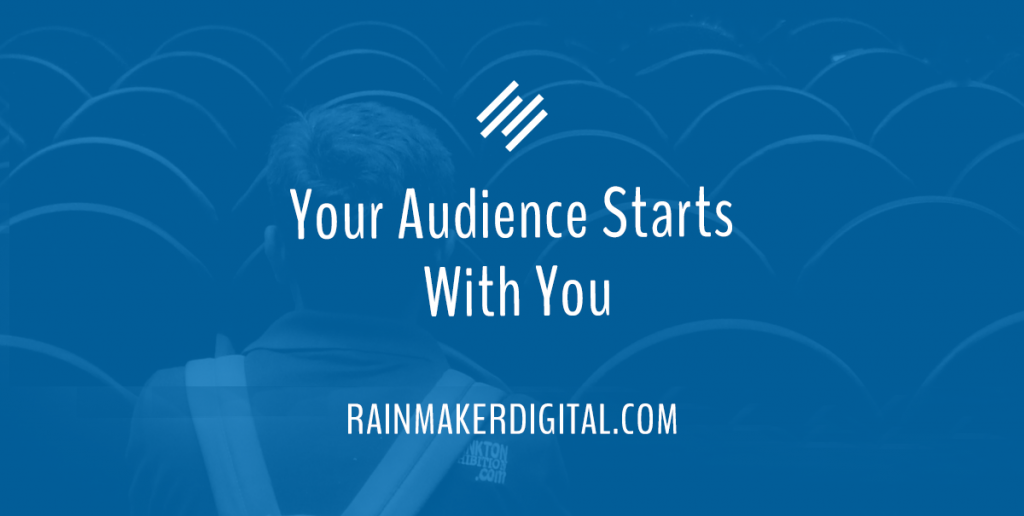
So … you want to start a company.
You have to do a lot of legwork before you get started. You know what you’re going to sell. You’ve planned it all out. Just one problem: who are you going to sell to?
There are three major sources of insight to consider when you start building your audience: yourself, your community and your data.
Yourself
Your audience starts with one person: you.
Great brands rely on creating personal connections to their products and services. That doesn’t mean everything you do has to be a passion project. But if you don’t care about your idea more than “it makes money,” it’s going to be a lot harder to find, know and grow your audience. Why do you care about the brand? Will people care about it for the same reasons?
Look at Patagonia. Yvon Chouinard was an avid outdoorsman long before he started the company. Chouinard started by making products he wanted to use. He cared about quality and environmental responsibility, and he knew there were others that did too. That group was Patagonia’s first audience.
If you’re close to your product like Chouinard, you know its benefits and value. You are the ideal customer. You know the pain points it fixes and can share those benefits with your audience better than anyone else.
When you’ve been around your field for a long time, you have a well-calibrated gut instinct. Start with that. Then supplement with other information.
Your Community
Listening to your community is a great way to learn whether your idea is viable as a business. Friends and advocates are extensions of you — they know you and they know what you care about. Run your ideas by them. Surround yourself with people who’ll give you an honest opinion. Then branch out.
Look at eBay. eBay began with Pierre Omidyar in 1995. It was originally called AuctionNet, and Omidyar began it as a hobby when his girlfriend was looking for an easy way to expand her Pez dispenser collection. He thought there was potential in an online auction house and built the code over a weekend.
Omidyar’s volume grew fast. He was originally running it on his regular Internet account, but when volume grew his ISP forced him to upgrade to a business account. He had to charge fees to make a profit — and users happily paid them.
Each feature eBay added was a result of feedback, from customers as well as friends and family.
Listen to your community and solicit feedback from them. This is easier if you’re a member of that community already — you have personal connections and you know how to talk to them.
Use that feedback to tailor your offerings. Listen to what people want and give it to them.
Be careful — there is a balance. The old apocryphal Henry Ford quote “If I had asked people what they wanted, they would have said faster horses” still applies (even if there’s no evidence Ford actually said it). Apple in particular has had a habit of making the market move to them instead of the other way around, and you might be able to do the same. People don’t always know what they actually want.
Your Data
Collecting data was hard for much of marketing history. That’s not the case any more.
If you have an audience already, you can start mining for demographics with people who already care what you have to say. Look at lifestyle brands like Express — they spin off different verticals based on what they already know about their customers.
Start your data analysis with demographics.
- Age. How old are they? Does your idea appeal to specific generations?
- Interests. What else does your audience care about besides your idea?
- Challenges/opportunities. What is taking time, focus and money from your audience?
- Stage of life. Married? Single? Children? Retired? Empty nester?
- Location. Where do they live, how do they speak and when are they online? What cultural mores do you need to navigate? Culture is more than language and location. The closer you can identify with your audience, the easier it is to connect with them.
Social media statistics, market reports and other data can help you find your target. But be careful. Not everything can be sifted, sorted into a table and turned into quantifiable information. Rand Fishkin’s latest piece for SparkToro makes the point that marketing attribution is tough at the best of times. As adman Bill Bernbach once said, “We are so busy measuring public opinion that we forget we can mold it. We are so busy listening to statistics that we forget we can create them.”
Dig into the data, but don’t forget that your audience is made up of people. If marketers could have boiled people down to a simple equation, they would have many years ago. The best data scientists in the world still get caught out regularly — social sciences are hard to pin down.
Start on the Right Foundation
You, your community and your data work together to help you find your audience. It’s a process — and it’s not always easy. If you need a hand with finding the right audience for your company, contact us today. We’re here to help.
Best Regards,
Ed Bardwell
President
Rainmaker Digital Services